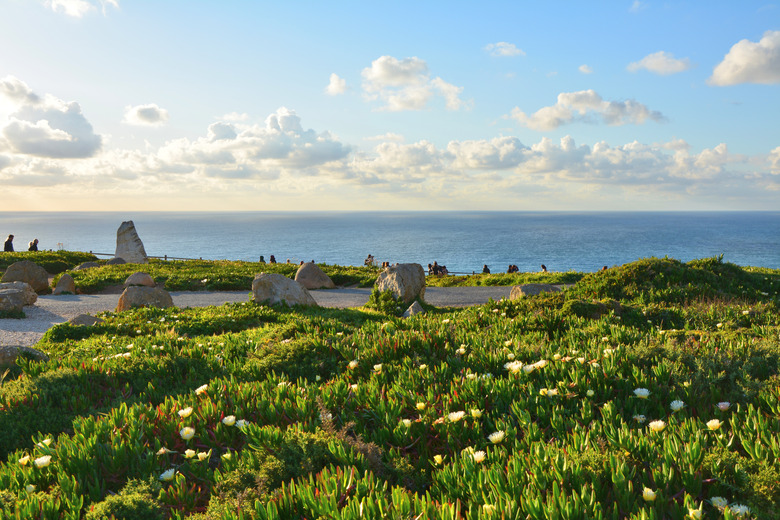About Prevailing Westerlies
In the middle latitudes of the Earth, weather – calm and fair sometimes, roaring and severe at other times – tends to ride in from the west. That's an account of the prevailing winds of this belt: the aptly named westerlies, which define the big-picture airflow from about 30 to 60 degrees latitude north and south of the equator.
The prevailing westerlies don't always cruise along in a straight-shooting west-to-east direction: they wiggle and sidewind, which helps make this zone of the globe home to the most fitful, changeable weather anywhere.
The Zoomed-Out View: Global Air Circulation
The Zoomed-Out View: Global Air Circulation
To understand how the westerlies are produced, we need to talk about global air circulation. The intense solar heating at the Earth's equator warms air and causes it to rise, forming a low-pressure belt around the planet.
Once this heated, rising air hits the stratosphere – the stable layer of the atmosphere above the lowest, the troposphere, where we live – it starts flowing poleward. Some of that air, though, is forced to descend around 30 degrees latitude to create zones of high-pressure known as the subtropical highs.
On the equator side of the subtropical highs, air flows toward the planet's low-pressure middle, deflected from a simple north-south route by the Coriolis force – the influence of Earth's rotation. Their course becomes easterly (i.e., directed toward the west). This is the trade winds definition: this easterly airflow. The Northern and Southern Hemisphere versions of this airflow run together near the equator to form the Intertropical Convergence Zone.
The poleward side of the subtropical highs has a roughly west-to-east airflow, producing – you guessed it – the westerlies.
Characteristics of the Westerlies
Characteristics of the Westerlies
Because of the curvature of the Earth and their location at higher latitudes, the westerlies cover less area than the trade winds, and they're also less consistent – partly because, close to the surface, they're impacted by more landmasses versus open ocean, and partly because they're modified by the atmospheric disturbances and storms that pulse through them.
At high altitudes, the westerlies are stronger and steadier, and their fastest wind speeds come in the form of two high "cores" of airflow generated by the strong vertical pressure differences near the troposphere/stratosphere boundary: the polar and subtropical _jet streams_.
The polar jet traces the seam between cold poleward air and warmer lower-latitude air: the polar front, which is also where, at lower altitudes, the westerlies edge against the polar easterlies (generated by the high pressure sitting over the poles).
The subtropical jet tends to blow a bit higher than the polar jet, marking where air subsides in the subtropical high.It's also generally weaker than the polar jet, and sometimes completely dissipates. The polar and subtropical jets, which shift position seasonally and sometimes merge into one, can strengthen whatever flow pattern is currently defining the westerlies.
Wiggles in the Westerlies: Rossby Waves
Wiggles in the Westerlies:
Rossby Waves
When the upper-air westerlies and the polar jet stream within them blow in a fairly straight west-east line – called zonal flow – cold polar air tends to stay in the high latitudes and warmer air in lower latitudes.
But the westerlies often develop meanders known as longwaves or Rossby waves (after the meteorologist, Carl-Gustav Rossby, who identified them), and these draw cold air equatorward (in low-pressure wave troughs) and warm air poleward (in high-pressure wave ridges) in a pattern of meridional flow.
In this way, Rossby waves help transport heat energy across the planet. They also help establish midlatitude weather, as fronts develop where the wave pushes air masses of different properties against one another, and temperatures and other conditions change depending on whether a location is under a trough or ridge.
Embedded in the slow-moving Rossby waves are faster, smaller shortwaves. Shortwave troughs can enhance longwave troughs, and the same goes for shortwave ridges. Conversely, a shortwave trough (ridge) can weaken a longwave ridge (trough). Shortwaves speeding through the Rossby waves provide an important trigger for storms, which are steered by the longwave track.
References
- Met Office: Global Circulation Patterns
- Meteorology: Understanding the Atmosphere; Steven Ackerman, John A. Knox
- National Ocean Service: What is a Rossby Wave?
- Physical Geography: A Landscape Appreciation; Tom L. McKnight
- National Weather Service: Longwaves & Shortwaves
- Britannica: Atmospheric Circulation
Cite This Article
MLA
Shaw, Ethan. "About Prevailing Westerlies" sciencing.com, https://www.sciencing.com/prevailing-westerlies-4612137/. 22 November 2019.
APA
Shaw, Ethan. (2019, November 22). About Prevailing Westerlies. sciencing.com. Retrieved from https://www.sciencing.com/prevailing-westerlies-4612137/
Chicago
Shaw, Ethan. About Prevailing Westerlies last modified March 24, 2022. https://www.sciencing.com/prevailing-westerlies-4612137/
